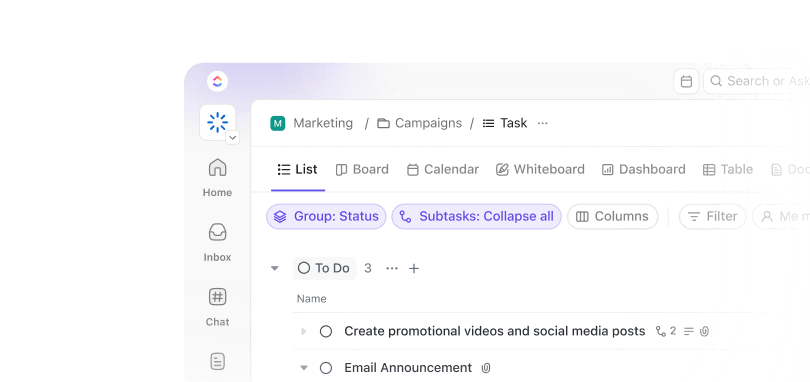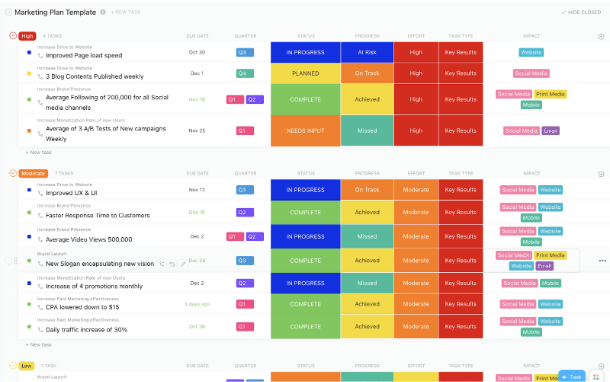People don’t shop online anymore—they live there. And ecommerce brands that get it, win.
Take Jacquemus. Instead of launching their Monte-Carlo store with a basic promo, they created a surreal beach club fantasy, complete with deadpan voiceovers, pastel visuals, and a wink at luxury itself.
No influencers. No hard sell. Just a bizarrely perfect fake world that got everyone talking.
This kind of creative restraint, paired with clever subversion, didn’t just sell fashion; it sold feelings. This resulted in a viral hit that lived on screens long after the campaign ended.
If your e-commerce brand is still playing it safe, this guide lays out the marketing strategies that are actually moving the needle right now.
⭐ Featured Template
For brands ready to move beyond campaign-to-campaign thinking, the Strategic Marketing Plan Template by helps to zoom out and focus on long-term goals. It’s built to align big-picture objectives with tactical execution and is perfect for teams planning quarterly sprints or annual roadmaps.
Why you’ll love this template
- Map out quarterly objectives and key results with the OKRs View for focused execution
- Use Milestones to break big strategies into clear, trackable phases
- Track budget, timelines, and team workload using built-in Custom Fields and resource management tools
How to Implement Effective Marketing Strategies for E-commerce Success
What Are E-commerce Marketing Strategies?
E-commerce marketing strategies make up the playbook brands use to attract customers to their online store, convince them to buy, and keep them coming back.
These tactics, from SEO and email marketing to social media channels and influencer partnerships, are built to drive traffic, increase online sales, and create loyal customers.
What makes e-commerce marketing unique?
E-commerce marketing strategy doesn’t follow the usual marketing script. You don’t get to nurture leads over months or book demos. You’re pushing for action, fast. Here’s what sets it apart:
- The online sales cycle is brutally short: There’s no long courtship. People discover a product and buy it minutes later, or not at all. Your strategy should be to sell instantly
- Every product needs its own campaign: Each SKU may need its own messaging, keywords, landing page, and creative
- You’re always balancing demand and inventory: Driving traffic is pointless if your bestsellers are out of stock. Campaigns have to sync with logistics, something most marketers never think about
- Creativity gets throttled by performance data: In e-commerce, the best idea loses if it doesn’t convert. Branding takes a backseat to CTRs, ROAS, and abandoned cart recovery
- Your loyalty can disappear with one bad delivery: Customer retention expands to cover about ops, speed, packaging, and the last-mile experience, most marketers never touch
The E-commerce Growth Challenge
Scaling an e-commerce business sounds great until you try it. Growth doesn’t just expose weak spots; it creates entirely new ones. Here are three real challenges most brands don’t see coming:
Performance marketing plateaus
What worked at $10K/month in ad spend often falls apart at $100K. Audiences get saturated, CPAs climb, and your once-profitable campaigns stop scaling. Growth forces you to rebuild the same funnel repeatedly, not just feed more dollars into it.
Operational drag slows marketing down
Faster growth means more SKUs, more returns, and more backend chaos. Suddenly, your marketing team spends half its time waiting on inventory updates or fixing broken product feeds. Ops bottlenecks kill momentum long before the customer ever sees an ad.
Customer acquisition gets more expensive than what loyalty programs generate
Brands assume repeat purchases will offset high CAC, but most don’t calculate how long that payback takes. If your existing customers only buy again after 6 months, your cash flow may collapse before retention ever kicks in. Growth needs better timing, not just better offers.
🔍 Did You Know? The average e-commerce site sees 70.19% cart abandonment. That’s not a typo. Most people leave before buying—reminder emails and return policies help claw that back.
15 Proven Ecommerce Marketing Strategies (with Execution Tips)
Success in e-commerce marketing comes down to holding their attention long enough to earn the sale. Here are 15 ecommerce marketing tactics and some ecommerce marketing tips that are built to do both:
1. Make influencers part of the story, not just the sale
Traditional influencer posts don’t cut it anymore; audiences scroll past polished product shots.
What works now is casual, unpolished, conversational content that mimics real decisions and daily dilemmas.
For instance, instead of saying “I love these jeans,” you can have an influencer create a reel: “Help me choose which of these five pieces to return.” She tries each item on, offers real (but positive) commentary, and by the end, “accidentally” decides to keep them all. This influencer marketing tactic is a subtle plug wrapped in relatable behavior.
The clothing brand Zara has nailed this format, turning try-on dilemmas into viral mini-stories that drive engagement and conversions.


💡 Pro Tip: When picking influencers, don’t just chase high view counts, dig into their target audience. Look at comment quality, not just quantity. Are followers genuinely engaged, asking questions, tagging friends, or just dropping emojis? Think and then choose your influencers.
2. Flip the script on product launches
Instead of pushing products through traditional countdown hype, start with “What do you want us to drop next?” campaigns.
Brands can collect feedback through Social Media polls, rank options in stories, and build FOMO by showing the ‘losers’. Potential customers and buyers, hence, feel ownership over the final product and show up ready to convert.
Participation replaces persuasion. This social media marketing tactic works more than you can imagine.
3. Use limited drops to drive urgency and sell out fast
In one Shark Tank episode (Season 14, Episode 18), Sophie Nistico walked in with her brand See The Way I See, a clothing label built around mental health advocacy. She revealed that her collections are sold only in limited drops, with no paid ads, just community, storytelling, and scarcity.


She shared a striking stat: one of her drops brought in $260K in just 24 hours.
The brand doesn’t chase algorithms or discount codes. It relies on real demand, built-up anticipation, and the urgency of ‘if you miss it, it’s gone’. That model not only builds hype, it makes each sale feel personal.
4. Use email for behavior nudging, not just promos
Your welcome flow is wasted if it’s just a 10% discount code and a thank-you note.
Smart brands use the first five emails to shape browsing behavior, one email for top categories, another for UGC, and a third showcasing reviews filtered by buyer type. It’s less about shouting offers, more about steering discovery with intent.
📮 Insight: While 78% of our survey respondents are big on setting goals, only 34% take time to reflect when those goals don’t pan out. 🤔 That’s where growth often gets lost.
With Docs and Brain, a built-in AI assistant, reflection becomes part of the process, not an afterthought. Automatically generate weekly reviews, track wins and lessons, and make smarter, faster decisions moving forward.
💫 Real Results: users report a 2x increase in productivity because building a feedback loop is easy when you have an AI assistant to brainstorm with.
5. Create ‘shop-by-vibe’ landing pages, not just categories
Most e-commerce filters are mechanical, by size, color, or price.
But paying customers don’t think like spreadsheets. They shop by vibe, such as ‘For your next weekend trip’, ‘Mood: Cozy & Oversized’, ‘Gifts under $50 for People You Kind of Like’.
Look at this landing page by Anice Jewellery:


Pages like these mimic how people browse in-store. Brands like Glossier and Madewell do this well by shifting the context from ‘What Is This?’ to ‘When would I use this?’ That’s what makes people click and keep scrolling.
6. Turn return policies into conversion triggers
Most customers don’t read your return policy, unless they’re unsure. Flip that hesitation by marketing it like a perk: “Try three sizes, keep one, return free.” Frictionless returns reduce cart anxiety, especially for higher-ticket or fit-sensitive products.
7. Build a referral loop that doesn’t feel like a pitch
Most ‘Refer a friend’ widgets get ignored because they feel like a brand asking for a favor.
Flip the framing. Reward both sides, but position the share as a flex. For instance, look at how Amerisleep has a page dedicated to referrals:


You can also pair it with time-limited exclusives or early drops. When referrals feel like access instead of chores, people promote you without being asked twice.
8. Gamify engagement without making it feel like a game
Most brands gamify to get customers. Smarter ones gamify to keep them.
Rover does this well with a layered rewards program that awards credits for writing reviews, signing up for emails, and referring friends.


What makes it effective is the mix; it’s not just points-for-purchase, but small, diverse triggers that re-engage users across touchpoints. And credits mean future bookings, which naturally lead to repeat behavior. It’s habit-building dressed as fun.
💡 Bonus Tip: Use gamification to map attention where it counts: underexplored categories, new arrivals, or low-CTR product lines. Give users a reason to stay longer than 60 seconds.
9. Use review requests as a content marketing strategy
Asking for reviews isn’t just about collecting stars. The most innovative brands ask the right kind of review.
Instead of ‘How was your order?’, prompt things like: ‘How did this fit vs. what you expected?’ or ‘What would you pair it with?’
These structured prompts generate content that becomes repurposable across PDPs, emails, and ads. For instance, look at this email sent by a brand called Sun of a Beach:


10. Turn packaging into a post-purchase marketing channel
Most brands stop marketing once the box is shipped. Smart ones treat packaging as the next ad space. A good unboxing is social bait—users want to post it, and followers want to shop it.
Take Theatre.xyz, an Indian footwear brand that nails this:


Their Shakespeare-themed packaging doesn’t just deliver the product; it delivers a moment. And those moments turn into free reach via Instagram, unboxing Reels, and comments like “Link pls” from buyers already sold on the vibe.
Besides, this packaging helps them leverage a lot of user-generated content through multiple social media posts.
💡 Pro Tip: Slip in QR codes for exclusive content. Include a reward for sharing. Or print a personal message that makes the buyer feel like they’re part of something more than just a transaction.
11. Geo-targeted offers without getting creepy
No one wants an email that says, “Hey, we see you’re in Milwaukee.” But geographic segmentation is powerful when used with nuance.
Brands running climate-based promotions (e.g., pushing rain gear where storms hit) or regional campaigns (“Back in stock in your area”) see better open and conversion rates than generic blasts. It feels timely, not intrusive.
12. Get smart with Google Shopping Ads
Google Shopping ads show your products right where buying decisions happen—on the first page of search results. They’re visual, direct, and high-converting because shoppers can see your product, price, and rating before even clicking.
What makes them even more powerful? Context!
For instance, if someone types in ‘multicolored skirt’ in Google, they don’t want a homepage; they want options, fast. Look at this Google result where brands like Shein, ASOS, and Temu appear before any organic listings, owning the moment of intent.


🤓 Friendly Hack: Before launching your next product push, audit 2–3 top rivals using a competitor research tool. Take what’s working for them, make it sharper, and optimize your landing page to outconvert your competitors.
13. Optimize product pages for long-tail SEO
SEO can deliver a massive share of your marketing goals—it helps attract qualified organic traffic with real buying intent. Long-tail keywords like ‘multicolor satin midi skirt under 3000’ or ‘cotton tiered maxi skirt for summer’ match what users search for when they’re ready to purchase.
Make sure you:
- Focus on optimizing individual product pages with these kinds of phrases
- Ensure your keyword research considers context to generate sales
- Add keywords naturally into titles, meta descriptions, alt text, and product descriptions
For instance, Luna Sandals writes 500+ word unique descriptions for each product, using language that mirrors how their customers search and shop—boosting both relevance and rankings.
14. Use product waitlists as pre-launch heat checks
Waitlists are marketing signals. They build desire, create social proof, and help you forecast inventory before investing in production.
Hermès has perfected this with the Birkin bag. You don’t just buy one, you join a wish list, build a relationship with the brand, and wait your turn.
They never scaled supply to match demand. Instead, they made the wait part of the story. The brand emphasized craftsmanship (it takes 40 hours to make one bag), turning every wishlist entry into a subtle brand-building campaign.
That scarcity strategy has driven both cultural relevance and resale value for decades. So much so that people literally, physically wait for hours on the launch day of a new collection:


This approach works for e-commerce brands even without a luxury positioning. You can use waitlists to gauge interest, reduce excess stock risk, and build buzz before a launch. When customers opt in, they’re already sold.
💡Pro Tip: What happens after you have all that waiting list data primed and ready to be actioned upon? Automate the follow-up processes. Whether you want to segment them into specific email lists or fast-track some of those orders, agentic workflows can take care of all of that. See how. 👇🏼
15. Bundle products with use-case positioning, not discounts
Instead of pushing ‘Buy 2, Get 1’ sales, shift the narrative to how the bundle fits into someone’s life.
Example: A skincare brand bundles a serum, sunscreen, and cleanser as ‘Your 3-Step Post-Workout Routine’.
You’re selling a solution, not just a discount—and that’s a much stronger reason to buy.
Building a strong ecommerce marketing strategy is one thing—keeping it all organized as your team grows is another.
1. (Your all-in-one AI-powered marketing command center)
For e-commerce teams juggling high volume, tight calendars, and cross-functional dependencies, , the everything app for work, serves as a force multiplier.
For instance, ’s Marketing gives brands a single place to manage everything, from campaign ideas and influencer planning to product launch calendars and content approvals.
With features like Lists, Docs, Tasks, and Calendar View, you can manage workflows across teams and keep every department in sync. Whether you’re coordinating UGC for a drop or tracking assets for a seasonal campaign, everything stays connected.
Combine competitor research and advanced analysis with one AI-powered platform
To start with, Brain, ’s AI assistant, acts as your all-in-one command center for ecommerce product research, launch, and order management.


It can help you:
- Instantly scan the web for the latest trends, competitor moves, pricing shifts, and customer sentiment, ensuring your product ideas are always grounded in up-to-date, actionable data
- Leverage multiple large language models to synthesize information, compare sources, and highlight emerging opportunities or risks in your niche
- Receive clear, AI-generated summaries and recommendations to validate product concepts, forecast demand, and identify gaps in the market before you invest
- Convert research findings directly into actionable tasks, assign owners, set deadlines, and link related docs or assets so every insight leads to concrete next steps
- Keep your entire team in sync with real-time updates, comments, and progress tracking, reducing miscommunication and ensuring everyone is aligned from ideation to launch
Set trackable goals and document every single detail via integrated docs
Want to scale and hit the next big growth goal? With Goals, you can create specific targets like ‘Launch three influencer campaigns this month’ or ‘Increase email open rate to 30%,’ and tie those directly to the work.
As team members complete tasks, the Goal progress auto-updates, giving everyone visibility and accountability without manual check-ins.


To keep all the nitty-gritty details on track, you need documentation. When that new product idea or iteration hits, you can use Docs for product briefs, Lists for product drops, Tasks for assignments, and the Calendar View to keep every launch deadline in check.
Docs helps you:
- Instantly generate product descriptions, FAQs, and marketing copy tailored to your brand and audience with built-in AI
- Summarize lengthy supplier contracts, policies, or meeting notes into clear, actionable takeaways
- Link related docs, tasks, and assets so your team always finds the right information when they need it
- Collaborate in real time with comments, suggestions, and AI-generated content, keeping everyone aligned and reducing bottlenecks
Seize sales trends in real-time with easy-to-build, no-code dashboards
Once your workflow is live, Dashboards help you see what’s live, what’s delayed, and what’s driving performance.
Say something is broken or a return needs to be processed faster. Enter Autopilot Agents. These are your digital teammates who can keep work moving based on pre-defined triggers.
This allows you to:
- Handle repetitive order management tasks like updating inventory, generating shipping labels, and sending customer notifications
- Ensure orders flow smoothly from purchase to delivery with real-time status updates
- Automatically flag and escalate order anomalies, stockouts, or shipping delays
- Deliver a better customer experience with faster, more accurate order handling
- Scale effortlessly as your order volume grows, with Agents ensuring consistent performance


2. Google Analytics (Best for tracking web traffic)
Google Analytics is a powerful web analytics tool that helps e-commerce businesses track and understand customer behavior on their websites. It provides insights into traffic sources, bounce rates, conversion rates, and user demographics, allowing businesses to make data-driven decisions to optimize their marketing efforts and improve the customer journey.
3. Hootsuite (Best for social media management)
Hootsuite is a social media management platform that enables e-commerce businesses to schedule posts, manage multiple social accounts, and track social media performance from one dashboard. It helps maintain a consistent online presence, engage with customers in real time, and analyze which content drives the most engagement and sales.
4. Shopify (Best for setting up ecommerce shops)
Shopify is a leading e-commerce platform that allows businesses to create, manage, and scale online stores easily. With customizable templates, built-in payment processing, and a wide range of apps, Shopify offers a user-friendly solution for selling products online and managing everything from inventory to shipping.
5. Mailchimp (Best for handling email campaigns)
Mailchimp is an all-in-one email marketing tool that helps e-commerce businesses create targeted campaigns, automate emails, and manage subscriber lists. It’s handy for sending personalized product recommendations, cart abandonment emails, and promotional messages, all of which help increase customer retention and sales.
6. SEMrush (Best for in-depth SEO research)
SEMrush is an SEO and digital marketing tool that enables businesses to improve their search engine visibility. It offers features like keyword research, site audits, and competitor analysis. For e-commerce, SEMrush helps optimize product listings and content to drive organic traffic and outperform competitors in search rankings.
7. Hotjar (Best for analyzing web traffic)
Hotjar provides heatmaps, session recordings, and user feedback tools, allowing e-commerce businesses to visualize how users interact with their websites. Businesses can make informed changes to improve usability, increase conversions, and enhance the shopping experience by identifying where users click, scroll, or drop off.
8. QuickBooks (Best for streamlining payments and related ops)
QuickBooks is an accounting tool that simplifies financial management for e-commerce businesses. It automates invoicing, tracks expenses, manages payroll, and generates financial reports. This ensures that your business stays financially organized and compliant, making it easier to monitor profitability and plan for growth.
Ready-made templates to kickstart your e-commerce marketing strategy
All set to roll? These pre-built marketing templates take the guesswork out of planning and execution.
Whether you’re launching a new product, mapping a content calendar, or aligning team goals, these templates help you move faster, stay organized, and hit your targets. Let’s look at some of these templates:
1. Marketing Plan template
The Marketing Plan Template by is perfect for those building their first full-scale ecommerce marketing strategy or overhauling an outdated one. It helps you break your goals down into campaigns, assign action steps, and monitor progress in real-time.
- Use the Timeline View to schedule campaign tasks and keep deadlines visible for the whole team
- Set measurable marketing KPIs using Goals and Custom Fields to track performance in real time
- Create a shared Progress Board so your team always knows what’s moving and what’s stuck
2. Content Management template
Managing content across formats, teams, and deadlines gets messy fast. The Content Management Template by gives you a single system to handle planning, production, reviews, and publishing without the usual back-and-forth. It is ideal for editorial calendars, blog schedules, and campaign assets.
- Use the Board View to manage content stages like Concept, In Development, and In Review with drag-and-drop simplicity
- Create Custom Fields to sort by channel, asset type, budget, or assigned writer
- Set up Dashboards to monitor publishing timelines and performance across formats
3. Campaign & Promotion Management template
Keep every campaign organized, on time, and results-driven. The Campaign & Promotion Management Template helps you plan every phase, assign ownership, and track performance—all from one place. Great for seasonal launches, promo pushes, or multi-channel marketing efforts.
- Map out campaigns across Calendar View to lock down dates, deliverables, and go-live timelines
- Track ROI using Custom Fields like audience funnel stage, channel, and launch status
- Use Automations to trigger next steps as tasks move from concept to launch
Here’s what Chelsea Bennett, the Brand Engagement Manager at Lulu Press, has to say about :
4. Social Media template
Manage all your social content in one place without losing track of what’s posting where. The Social Media Template by makes it easier to plan campaigns, create content, and collaborate across platforms with clarity and speed.
- Use the Content Calendar View to schedule posts and stay consistent across channels
- Track post status with Custom Statuses like For Approval or In Progress
- Collect team input with the built-in Content Suggestion Form to keep fresh ideas flowing
5. Weekly Content Calendar template
Stay ahead of publishing schedules without scattered docs or missed deadlines. The Weekly Content Calendar Template by helps you map weekly content, track progress, and align your team—without digging through spreadsheets.
- Organize all tasks by week using the Weekly Content View for a clear publishing schedule
- Add post details with Custom Fields for captions, hashtags, and design assets
- View timelines and upcoming posts using the Calendar View to avoid overlap or gaps
💫 Case Study: CEMEX, a global construction brand, cut its marketing time-to-market by 15% using . Their team of 50+ employees now manages campaigns, creative workflows, and stakeholder reviews—all in one place.
What once took hours now happens in seconds thanks to automation and better visibility. Proof that innovative systems scale, even in industries far from e-commerce.
🧨 More templates to power up your ecommerce marketing ops
Here are some additional ecommerce business plan templates to help you brainstorm faster, keep branding sharp, and test what’s actually working:
👉🏽 Campaign Launch Brainstorm template: Perfect for pre-launch planning, the Campaign Launch Brainstorm template is a whiteboard-style template that helps you break down target customers, messaging angles, and creative formats before a campaign goes live. Use it with your team to align early and avoid last-minute chaos.
👉🏽 Brand Style Guide template: Keep every piece of content on-brand with this easy-to-share style guide. With the Brand Style Guide template, you can document voice, tone, color palette, logo usage, and design rules so your team and contractors don’t need to second-guess brand consistency.
👉🏽 Campaign Brief template: The Campaign Brief template lays out campaign goals, channels, timelines, and messaging in a clear, collaborative format. It’s great for briefing internal teams, freelancers, or agency partners without the endless back-and-forth.
👉🏽 Advertisement template: Use the Advertisement template to organize all your ad assets, copy variations, creative specs, and placement details. It’s built to help you keep paid campaigns consistent, track what’s in review, and ship on time.
👉🏽 Growth Experiments Whiteboard template: Run structured experiments without messy docs or lost data. The Growth Experiments Whiteboard Template lets you brainstorm test ideas, define success metrics, and log results—all in one space that’s easy to update and reference.
Build, Track, and Scale Your E-commerce Marketing Strategy With
Running effective marketing strategies for e-commerce requires more than great ideas—it requires structure, speed, and visibility.
From planning product drops and building content calendars to tracking campaign ROI and streamlining collaboration, gives ecommerce teams everything they need to scale without the usual chaos.
The ready-to-use templates, intelligent automation, and built-in AI remove guesswork and help you execute clearly. Whether you’re launching influencer campaigns or running paid ads, turns strategy into a repeatable system.
Ready to organize, execute, and grow your e-commerce marketing like a pro? Get started with for free!


Everything you need to stay organized and get work done.

















